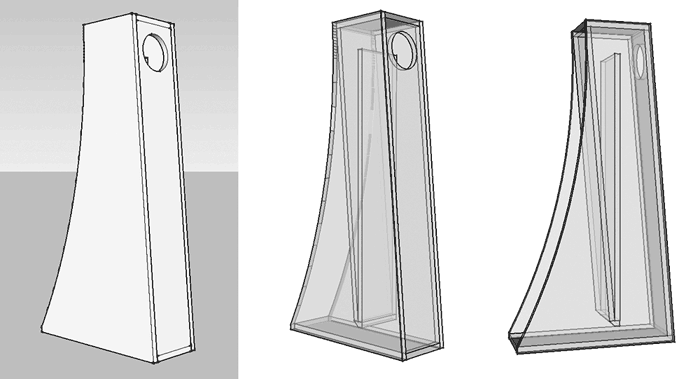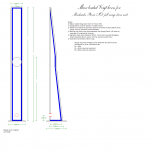Dug up your old post because the subject was of interest
Frugel-Horn Mk3
A Voigt pipe in the usual parlance is a conical horn tuned to 1/4 wavelength (there are exceptions) of the desired Fo & is rarely impedance matched in its functional BW (again, with certain exceptions). It's basically a standing-wave generator; having positive expansion that means 1/2 wave with a 1/4 wave fundamental. The ripples in the FR are a function of the pipe harmonics, just as they are in a straight pipe, albeit with both odd and even harmonics. FH3 is a hypex (hyperboilc) corner-horn, impedance matched to a much lower frequency. Different flare profile, different results, far less harmonic ripple through it's functional BW.
FH3 approximates a hypex / hyperbolic horn profile with two conical expansion stages between which a choke is inserted per Olson which helps block unwanted higher frequencies (viz. shorter wavelengths) from passing in either direction. Said choke has almost zero effect on Fo. As a corner / rear-boundary loaded design the expansion thus continues outside the box, like any other corner / 1/4 space design.
Frugel-Horn Mk3
A Voigt pipe in the usual parlance is a conical horn tuned to 1/4 wavelength (there are exceptions) of the desired Fo & is rarely impedance matched in its functional BW (again, with certain exceptions). It's basically a standing-wave generator; having positive expansion that means 1/2 wave with a 1/4 wave fundamental. The ripples in the FR are a function of the pipe harmonics, just as they are in a straight pipe, albeit with both odd and even harmonics. FH3 is a hypex (hyperboilc) corner-horn, impedance matched to a much lower frequency. Different flare profile, different results, far less harmonic ripple through it's functional BW.
FH3 approximates a hypex / hyperbolic horn profile with two conical expansion stages between which a choke is inserted per Olson which helps block unwanted higher frequencies (viz. shorter wavelengths) from passing in either direction. Said choke has almost zero effect on Fo. As a corner / rear-boundary loaded design the expansion thus continues outside the box, like any other corner / 1/4 space design.
For brevity, the above could be condensed to "It's a Voigt-style (aka 'chamberless', aka 'pipe', aka 'tapped') hypex corner horn."  The Voigt pipe as typically referred to is a standing-wave generator since it's not impedance matched over any portion of its effective operating BW. Strictly speaking, having parallel sides, the latter is more a parabolic than conical, but under most conditions where the term is used, the difference in behaviour is negligable.
The Voigt pipe as typically referred to is a standing-wave generator since it's not impedance matched over any portion of its effective operating BW. Strictly speaking, having parallel sides, the latter is more a parabolic than conical, but under most conditions where the term is used, the difference in behaviour is negligable.
There are plenty of Voigt style (as in chamberless) horns though. The BIB is a good example, and they can work very well.
There are plenty of Voigt style (as in chamberless) horns though. The BIB is a good example, and they can work very well.
Last edited:
How do you not end up with exaggerated bass from the extra gain? There doesnt seem to be any measurements of the FHs to see what is exactly going on with their response and to compare to the pensil for example but from people's comments it sounds like the provide similar bass quantity.
When carefully engineered, the amount of low frequency gain of a back loaded “bass horn” is designed to compensate for the driver’s falling output “below its mass corner”, if I recall the terminology correctly?
Can certain combinations of such gain, driver’s native response, corner boundary loading and perhaps high amplifier output impedence deliver excessive bass? Quite possibly yes; in the case of the Frugels, anticipation of that was considered in the advice to tailor individual systems by adjusting levels of acoustic damping in the section of expansion below the driver.
Scott will likely enter the conversation again to correct or expand on this gross over simplification.
Can certain combinations of such gain, driver’s native response, corner boundary loading and perhaps high amplifier output impedence deliver excessive bass? Quite possibly yes; in the case of the Frugels, anticipation of that was considered in the advice to tailor individual systems by adjusting levels of acoustic damping in the section of expansion below the driver.
Scott will likely enter the conversation again to correct or expand on this gross over simplification.
Yoy won’t see many measures and what you see will only tell you how well the box does in the room it is in and where it is.
In FHs one can adjust the amount of bass gain by varying the stuffing. Some gain is often wanted to compensate for 2π to 4π transition.
Instead of decreasing themidTop to get BSC as one does with a filter, there is no need, it is acoustic and adjustable.
dave
In FHs one can adjust the amount of bass gain by varying the stuffing. Some gain is often wanted to compensate for 2π to 4π transition.
Instead of decreasing themidTop to get BSC as one does with a filter, there is no need, it is acoustic and adjustable.
dave
Dug up your old post because the subject was of interest
FH3 approximates a hypex / hyperbolic horn profile with two conical expansion stages between which a choke is inserted per Olson which helps block unwanted higher frequencies (viz. shorter wavelengths) from passing in either direction. Said choke has almost zero effect on Fo. As a corner / rear-boundary loaded design the expansion thus continues outside the box, like any other corner / 1/4 space design.
I am trying to understand this, but failing. I cannot see the choke between the 2 conical sections. And to me the 2 conical sections are all but identical expansion rates. I am missing things here.
I think it looks like a quarter horn down to the opening.
But what happens there seems to be an expanded horn.
Since the speaker is to stand against a wall, the back wall forms a continuation of the horn. That's probably why the sides are so deep. They fulfill their function.
But what happens there seems to be an expanded horn.
Since the speaker is to stand against a wall, the back wall forms a continuation of the horn. That's probably why the sides are so deep. They fulfill their function.
Last edited:
Apologies for my lack of clarity. I read the original explanation (probably incorrectly) as meaning the second conic section had a different expansion rate to the first section. If they are the same does it mean all "Voigt" style pipes are hypex.
Is the choke mentioned created by the geometry, or the stuffing?
I am hoping to hear a pair soon, and would really like to appreciate and understand the design more.
Is the choke mentioned created by the geometry, or the stuffing?
I am hoping to hear a pair soon, and would really like to appreciate and understand the design more.
I read the original explanation (probably incorrectly) as meaning the second conic section had a different expansion rate to the first section. If they are the same does it mean all "Voigt" style pipes are hypex.
Again, any pipe/horn with parallel sides is always technically a parabolic expansion defined [ Hornresp] by its mouth flare tangent angle [degrees].

From this we see it's divided by straight boards = constant expansion and its pipe horn terminus/vent/'choke' [2nd expansion] has a curved divider/terminus/mouth to the corner, so has a plurality/multiple constant expansions to approximate a hypex/whatever flare frequency [Hz].
Voigt's seminal 774,479 patent is about offset driver, compound [driver front, rear loaded] loaded pipes/horns, so between the patent and the typical way 'we' design/build the various types, they are normally parabolic: _S341083 | Round Person | Flickr
- Home
- Loudspeakers
- Full Range
- Frugel-Horn and Voigt relationship
